What We’re Reading: June 15th Edition
Plant Vitamins and Cofactors Special Issue
This week’s “What We’re Reading” summarizes recent findings on plant vitamin and cofactor biosynthesis and their role in plant defense responses. This selection includes two reviews and nine research papers. The first review focuses on biofortification strategies for cofactors and other plant nutrients to meet the nutritional needs of both developing and developed countries; the second is centered on strategies for B vitamins biofortification and the interplay of their metabolic pathways. The research papers cover new findings in vitamin/cofactor biosynthesis, specific biofortification attempts and the role of nicotinic compounds in plant defense. The selection ends with an interesting comparison between conventional and integrated agricultural management strategies for what concerns crops nutritional values.
Guest Editor: Dr. Elisa Dell’Aglio
 Elisa holds a PhD in Plant Biochemistry from the University of Grenoble – CEA (France) and just finished her first Post-Doc at the University of Geneva, Switzerland. She has been a Plantae Fellow since September 2017. During her career, she has focused on root-fungal interactions and plant proteins interactions. Her current work is aimed at understanding how cofactors, such as NADP and Vitamin B6, help plants to overcome abiotic and biotic stress conditions. Since June 2018, she is Secretary of AIRIcerca, the International Association of Italian Researchers. While away from the bench, she reads and writes about science and life as a scientist.
Elisa holds a PhD in Plant Biochemistry from the University of Grenoble – CEA (France) and just finished her first Post-Doc at the University of Geneva, Switzerland. She has been a Plantae Fellow since September 2017. During her career, she has focused on root-fungal interactions and plant proteins interactions. Her current work is aimed at understanding how cofactors, such as NADP and Vitamin B6, help plants to overcome abiotic and biotic stress conditions. Since June 2018, she is Secretary of AIRIcerca, the International Association of Italian Researchers. While away from the bench, she reads and writes about science and life as a scientist.
Review: Medicine Is not Health Care, Food Is Health Care: Plant Metabolic Engineering, Diet and Human Health (OA)
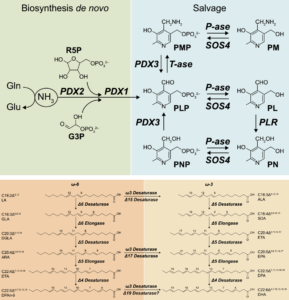 New Phytol. One of the consequences of the green revolution has been the increasing dependence on few staple crops, which provide calories but often lack the right amount of micronutrients such as vitamins and minerals. The consequences are collectively called “hidden hunger” and concern not only poor countries but also some populations of rich countries. This is due to the increase in the costs of high quality fruits and vegetables, to the lack of interests from breeding programs (which mainly focus on yield and pest resistance) and to the strong appeal of processed food for consumers.
New Phytol. One of the consequences of the green revolution has been the increasing dependence on few staple crops, which provide calories but often lack the right amount of micronutrients such as vitamins and minerals. The consequences are collectively called “hidden hunger” and concern not only poor countries but also some populations of rich countries. This is due to the increase in the costs of high quality fruits and vegetables, to the lack of interests from breeding programs (which mainly focus on yield and pest resistance) and to the strong appeal of processed food for consumers.
The authors summarize many recent attempts of phytonutrients (such as vitamins and polyphenols) biofortification in crops by traditional means (breeding) and genetic engineering. From this analysis, it appears that most of the successful genetic engineering approaches provided only a mild increase of the selected nutrient. This may be because these approaches often target only one or a few genes. In addition, attention must be given to the gene promoters, to increase micronutrient production only in the target tissues and not waste energy. Finally, genetic engineering has mainly focused on “pull” strategies (i.e. the enhancement of biosynthesis) and rarely on “protect” strategies (i.e. increasing the nutrient storage or reducing its catabolism). Our increasing understanding of the regulation of biosynthetic pathways should lead us to better exploit the possibilities offered by the protect strategies.
Even so, in order to accomplish real progress in human nutrition, micronutrient-rich varieties have to be grown by farmers. This means they do not have to impact the yield or be susceptive to parasites, or that public investment have to be allocated in order to promote these varieties, sometimes against the market. (Summary by Elisa Dell’Aglio) New Phytol. 10.1111/nph.14730
Review: Toward Eradication of B-Vitamin Deficiencies: Considerations for Crop Biofortification (OA)
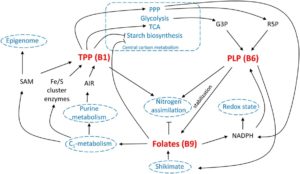 Front. Plant. Sci. Micronutrient malnutrition (or “hidden hunger”) is estimated to concern one fourth of the human population worldwide and its main victims are children and pregnant women. This review summarizes the biosynthetic pathways, the role in plant physiology and the recent efforts of the scientific community to overcome dietary deficiencies of three vitamins: B1, B6 and B9.
Front. Plant. Sci. Micronutrient malnutrition (or “hidden hunger”) is estimated to concern one fourth of the human population worldwide and its main victims are children and pregnant women. This review summarizes the biosynthetic pathways, the role in plant physiology and the recent efforts of the scientific community to overcome dietary deficiencies of three vitamins: B1, B6 and B9.
Genetic engineering was successfully applied to increase folate content in potatoes and B6 content in cassava roots (up to levels that match the recommended daily intake). On the other hands, breeding programs may be preferable to increase folate content in rice and B1 content in many crops, using the high variation in vitamin levels in natural varieties.
The authors also remind the importance of evaluating two important aspects: the vitamin stability upon storage and processing (cooking, polishing…) and the potential interplay of the B vitamin biosynthetic pathways. (Summary by Elisa Dell’Aglio) Front. Plant. Sci. 10.3389/fpls.2018.00443
Genomic Insights into the Evolution of the Nicotine Biosynthesis Pathway in Tobacco (OA)
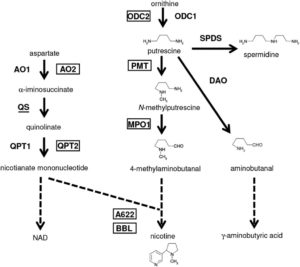 Plant Physiol. Nicotine is a NAD-related secondary alkaloid found in high concentration in the leaves of the tetraploid tobacco plant (Nicotiana tabacum).
Plant Physiol. Nicotine is a NAD-related secondary alkaloid found in high concentration in the leaves of the tetraploid tobacco plant (Nicotiana tabacum).
The recent sequencing of the N. tabacum genome allowed a comprehensive analysis of genes involved in NAD and nicotine biosynthesis. The analysis revealed the presence of a nicotine regulon, constituted of genes involved in the last steps of the nicotine pathway, under the control of ERF transcription factors. In contrast, genes of early steps in nicotine biosynthesis overlap with NAD biosynthesis and are often duplicated: one gene of each type is part of the nicotine regulon. It usually contains P-box and MYC2-binding G-box elements in the promoter region. The other gene lacks nicotine-related TF binding sites, its expression is not restricted to nicotine-producing tissues and is therefore likely involved in primary metabolism (NAD production) rather than nicotine biosynthesis.
The genome sequencing also allowed the elucidation of the NIC2 locus which contains several transcription factors regulating nicotine biosynthesis and its modifications in a low-nicotine variant.
This work provides the basis to further understand the dynamic of the regulation of NAD and nicotine in tobacco. (Summary by Elisa Dell’Aglio) Plant Physiol. 10.1104/pp.17.00070
A Lectin Receptor Kinase as a Potential Sensor for Extracellular Nicotinamide Adenine Dinucleotide in Arabidopsis thaliana (OA)
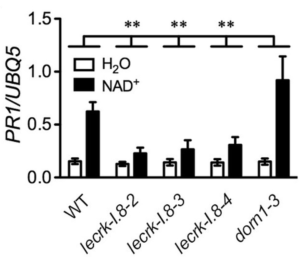 eLife Besides its role as an enzyme cofactor, NAD is also a plant signaling molecule. In particular, it leaks from wounded areas and activates defense pathways in the neighboring tissue, an effect that can be mimicked by application of extracellular NAD.
eLife Besides its role as an enzyme cofactor, NAD is also a plant signaling molecule. In particular, it leaks from wounded areas and activates defense pathways in the neighboring tissue, an effect that can be mimicked by application of extracellular NAD.
The presence of a sensing mechanism for extracellular NAD levels was therefore suggested. To identify potential NAD membrane receptors, a microarray analysis of exogenous NAD-induced genes was performed and LecRK-I.8 was identified as a good candidate. The authors demonstrated that LecRK-I.8 is localized at the plasma membrane and that its intracellular domain exhibits kinase activity.
Although the NAD binding parameters are not fully in line with the extracellular NAD levels able to trigger a defense response, it was shown that LecRK-I.8 can bind NAD but not other related molecules such as NADP. Furthermore, mutations of the putative NAD binding site block NAD activation of defense genes but not NADP+-, flg22-, and SA-induced defense responses, thus corroborating its role as a specific NAD receptor.
This work establishes NAD signaling as part of the defense response of Arabidopsis. Further work is required to confirm these findings in other plant species and identify other components of the signaling pathway. (Summary by Elisa Dell’Aglio) eLife 10.7554/eLife.25474
Nicotinamide Mononucleotide and Related Metabolites Induce Disease Resistance Against Fungal Phytopathogens in Arabidopsis and Barley (OA)
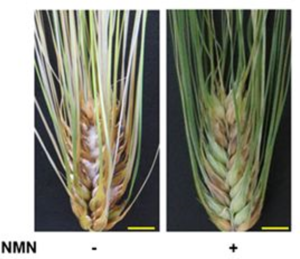 Sci. Rep. Plant defense activators are organic molecules that do not possess antimicrobial activity but have been shown to enhance plant disease resistance mechanisms. A comparison of some Fusarium-resistant and -susceptible barely cultivars suggested that NMN may act as a plant defense activator.
Sci. Rep. Plant defense activators are organic molecules that do not possess antimicrobial activity but have been shown to enhance plant disease resistance mechanisms. A comparison of some Fusarium-resistant and -susceptible barely cultivars suggested that NMN may act as a plant defense activator.
RNAseq data revealed salicylic acid induction and cell death repression in NMN-pretreated Arabidopsis leaves inoculated with F. graminearum, while jasmonic acid and ethylene signaling appeared to be downregulated. Protective effects were also visible in NMN-pretreated barley plants as well as in NMN-pretreated Arabidopsis salicylic-acid (SA) deficient sid2 mutant, suggesting that the enhanced disease resistance also involves SA-independent signaling pathways.
To observe the effects of endogenously produced nicotinamide cofactors, the NMNAT gene – which converts NMN to NAD and represents a bottleneck of the biosynthetic pathway – was overexpressed. NMNAT overexpression was successful in increasing both the endogenous NAD content and plant resistance. Thus, modulation of nicotinic cofactors appears to be a valuable strategy to increase plant resistance to pathogens. (Summary by Elisa Dell’Aglio) Sci. Rep. 10.1038/s41598-017-06048-8
The Arabidopsis Thiamin‐Deficient Mutant pale green1 Lacks Thiamin Monophosphate Phosphatase of the Vitamin B1 Biosynthesis Pathway ($)
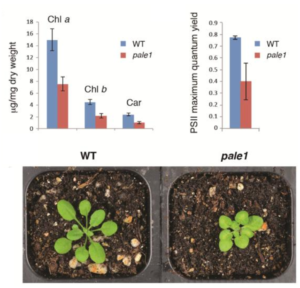 Plant J. Plants have the capacity of building several vitamin compounds that animals must uptake with their diet instead. Some of these pathways, such as the B1 pathway, are extremely complex and still not completely elucidated.
Plant J. Plants have the capacity of building several vitamin compounds that animals must uptake with their diet instead. Some of these pathways, such as the B1 pathway, are extremely complex and still not completely elucidated.
The At5g32470 gene was identified as a new thiamine monophosphate (TMP) phosphatase by Mimura et al, 2016. The analysis of a new mutant line named pale green 1 corroborated their findings. However, Hsieh et al now raise the hypothesis that this protein is located in the mitochondrion rather than in the cytosol as previously concluded. If these data are confirmed, this would imply a transport mechanism of TMP from the chloroplast where it is produced to the mitochondrion, as well as a passage of thiamine back to the cytosol for conversion to the active form thiamine triphosphate (TPP) by thiamine pyrophosphatases, which, to our knowledge, are located in the cytosol.
Interestingly, the pale green 1 line comes from a T-DNA insertion collection but the mutation in the At5g32470 is a collateral point mutation. (Summary by Elisa Dell’Aglio) Plant J. DOI: 10.1111/tpj.13552 (See also Mimura et al, Plant Cell 10.1105/tpc.16.00600)
Aldehyde Dehydrogenases Function in the Homeostasis of Pyridine Nucleotides in Arabidopsis thaliana (OA)
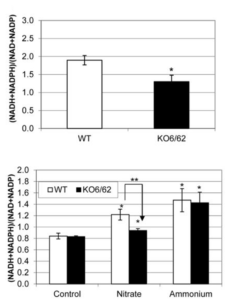 Sci. Rep. Aldehyde dehydrogenase enzymes (ALDHs) are very common proteins involved in the oxidation of aliphatic and aromatic aldehydes to their corresponding carboxylic acids, using NAD and NADP as electron acceptors.
Sci. Rep. Aldehyde dehydrogenase enzymes (ALDHs) are very common proteins involved in the oxidation of aliphatic and aromatic aldehydes to their corresponding carboxylic acids, using NAD and NADP as electron acceptors.
In this paper the authors explore the hypothesis that ALDHs are also important modulators of cellular redox homeostasis through modulation of NAD(P)/NAD(P)H ratios. They measured NAD(P) and NAD(P)H in single and double Arabidopsis ALDH mutant lines (aldh3I1/aldh7B4), and found significant alterations in the concentrations of these metabolites. In parallel, glucose-6-phosphate dehidrogenase activity was shown to increase in the double mutant. The increase was significant in both 6-week-old plants in normal conditions and nitrate-challenged 2-week-old seedlings.
The reported findings, together with a reduction in photosynthetic efficiency of the double mutant, agree with an interdependency between pyridine nucleotides, cellular redox and photosynthesis and suggests a role of ALDHs as contributors to the cellular redox homeostasis. (Summary by Elisa Dell’Aglio) Sci. Rep. 10.1038/s41598-018-21202-6
P-HYDROXYPHENYLPYRUVATE DIOXYGENASE from Medicago sativa Is Involved in Vitamin E Biosynthesis and Abscisic Acid-Mediated Seed Germination (OA)
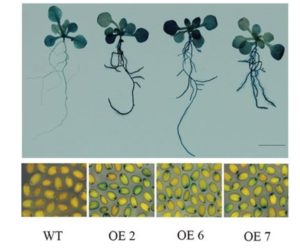 Sci. Rep. Vitamin E has been shown to scavenge singlet oxygen, reduce lipid oxidation by-products and inhibit lipid peroxidation, thereby helping plant defenses against various stresses.
Sci. Rep. Vitamin E has been shown to scavenge singlet oxygen, reduce lipid oxidation by-products and inhibit lipid peroxidation, thereby helping plant defenses against various stresses.
In this study, the authors identified MsHPPD as a key gene for vitamin E biosynthesis in alfalfa – an important crop and a model species for nitrogen fixation studies. The identification was initially hypothesized by sequence comparison with Arabidopsis and Medicago genes. The gene was shown to be highly expressed in leaves and induced following abiotic stress conditions such as salt, PEG and ABA treatments, as well as dark to light transition.
Hyperaccumulation of vitamin E (total vitamin and in particular β-tocotrienol and δ-tocopherol) was observed in transgenic lines overexpressing MsHPPD. The overexpression was also inked to fast seed germination in normal conditions and an increased germination rate when seeds were exposed to abiotic stress (i.e. salt or ABA treatments). In parallel, a reduced ABA content was measured in MsHPPD overexpressing seeds, as well as reduced expression of ABA-related transcripts. This leads to the hypothesis that vitamin E promotes alfalfa seed germination via a repression of the ABA pathway. (Summary by Elisa Dell’Aglio) Sci. Rep. 10.1038/srep40625
The Manipulation of Gene Expression and the Biosynthesis of Vitamin C, E and Folate in Light-and Dark-Germination of Sweet Corn Seeds (OA)
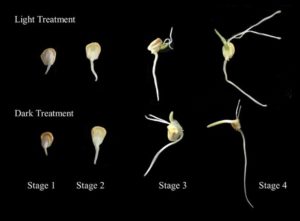 Sci. Rep. There is an increasing body of evidence suggesting that the vitamin content of cereal sprouts is higher than the one of cereal kernels. For example, it was recently shown that niacin, riboflavin and ascorbic acid accumulate during sweet corn sprouting. Liu and colleagues went further by measuring the vitamin content at several sprouting stages. They focused on vitamin C and E (both powerful antioxidants involved in the elimination of free radicals) and vitamin B9 (or folate, involved in DNA duplication and development). Sprouting was divided in 4 stages and observed both in dark and light conditions.
Sci. Rep. There is an increasing body of evidence suggesting that the vitamin content of cereal sprouts is higher than the one of cereal kernels. For example, it was recently shown that niacin, riboflavin and ascorbic acid accumulate during sweet corn sprouting. Liu and colleagues went further by measuring the vitamin content at several sprouting stages. They focused on vitamin C and E (both powerful antioxidants involved in the elimination of free radicals) and vitamin B9 (or folate, involved in DNA duplication and development). Sprouting was divided in 4 stages and observed both in dark and light conditions.
Besides providing interesting clues about vitamin production in sweet corn and interplay of the various metabolic pathways, this study supports the consumption of sweet corn sprouts for a vitamin-rich diet. (Summary by Elisa Dell’Aglio) Sci. Rep. 10.1038/s41598-017-07774-9
Folate Biofortification of Potato by Tuber-Specific Expression of Four Folate Biosynthesis Genes ($)
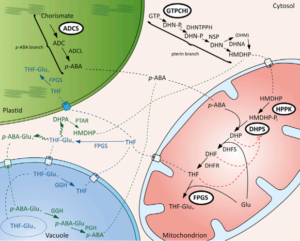 Mol. Plant Deficiency in Vitamin B9 (folate) is one of the major causes of birth defects and maternal deaths. As potato is a staple crop for several populations worldwide, one strategy to reduce the risks of folate deficiency is the biofortification of potato. This would be extremely useful, as the natural variation in folate content is very low (3-4 folds) and therefore breeding programs are unlikely to be successful. Rice and tomatoes were recently enriched in folate by overexpressing the genes GTPCHI and ADCS. However, the same strategy previously led only to accumulation of folate precursors in potato. The authors improved this strategy by overexpressing other two additional genes: HPPK/DHPS and FPGS in the potato cultivar Desirée. The two additional genes would sustain the last folate biosynthetic steps that are located in the mitochondria. Patatin promoters were used, to ensure specific expression in the tubers.
Mol. Plant Deficiency in Vitamin B9 (folate) is one of the major causes of birth defects and maternal deaths. As potato is a staple crop for several populations worldwide, one strategy to reduce the risks of folate deficiency is the biofortification of potato. This would be extremely useful, as the natural variation in folate content is very low (3-4 folds) and therefore breeding programs are unlikely to be successful. Rice and tomatoes were recently enriched in folate by overexpressing the genes GTPCHI and ADCS. However, the same strategy previously led only to accumulation of folate precursors in potato. The authors improved this strategy by overexpressing other two additional genes: HPPK/DHPS and FPGS in the potato cultivar Desirée. The two additional genes would sustain the last folate biosynthetic steps that are located in the mitochondria. Patatin promoters were used, to ensure specific expression in the tubers.
With this approach, a 12-fold increase in total folate content was achieved. The same strategy can now be applied to other potato cultivars, hopefully leading to similar results. (Summary by Elisa Dell’Aglio) Mol. Plant org/10.1016/j.molp.2017.12.008
Impact of Conventional and Integrated Management Systems on the Water-Soluble Vitamin Content in Potatoes, Field Beans, and Cereals ($)
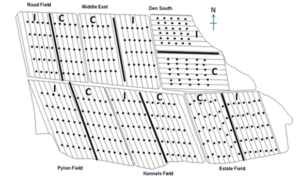 J. Agric. Food Chem. Agriculture in the EU is shifting towards a more sustainable use of resources and preservation of the biodiversity. This process requires a careful assessment of the balance between economic and environmental demands. To achieve this goal, the James Hutton Institute set up a long-term experimental platform.
J. Agric. Food Chem. Agriculture in the EU is shifting towards a more sustainable use of resources and preservation of the biodiversity. This process requires a careful assessment of the balance between economic and environmental demands. To achieve this goal, the James Hutton Institute set up a long-term experimental platform.
Freitag et al. present a comparison between conventional and integrated agricultural management in Scotland for what concerns crops nutritional values. The experiment lasted for five years (from 2010 to 2015) and was conducted on several varieties of potato, field beans, Spring barley, Winter barley and Winter wheat. The researchers compared the concentrations of five water soluble vitamins: nicotinic acid, pyridoxine, thiamine, riboflavin, and pantothenic acid.
This comprehensive work did not highlight any significant improvement in vitamin content for the integrated-grown crops. The only change between the two agricultural systems – consistent in several crops – was a lower level of thiamine in the integrated-grown crops. This is coherent with previous findings that suggested a link between a surplus of ammonium fertilization and an increase of vitamin B1 in crops. (Summary by Elisa Dell’Aglio) J. Agric. Food Chem. 10.1021/acs.jafc.7b03509



